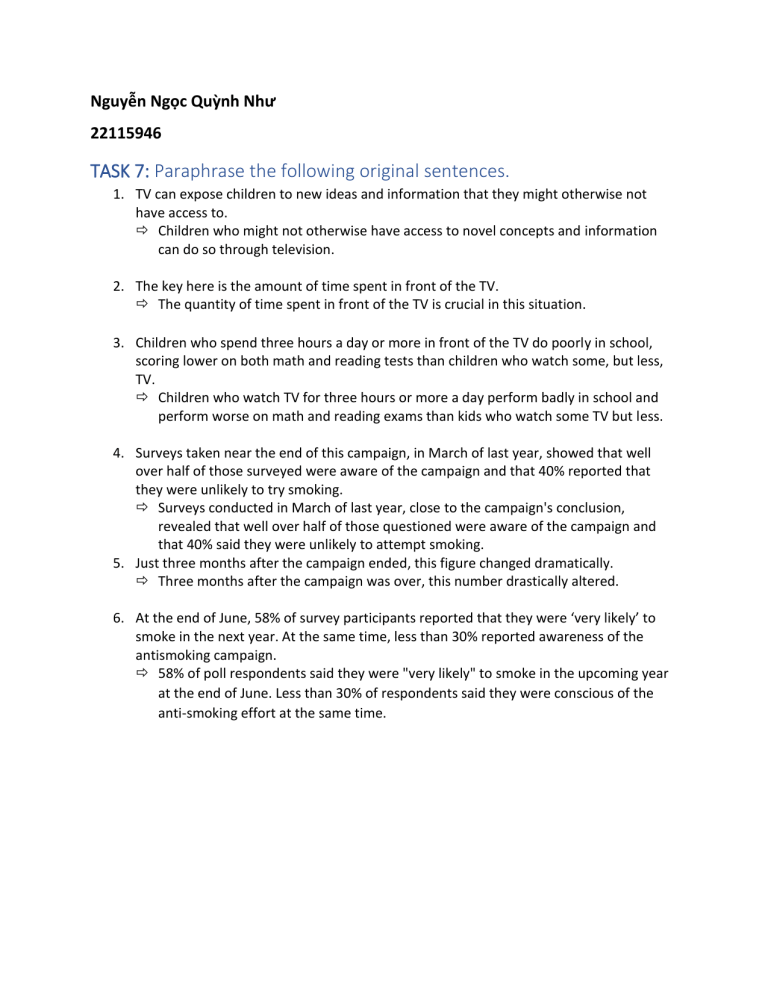
Nguyễn Ngọc Quỳnh Như 22115946 TASK 7: Paraphrase the following original sentences. 1. TV can expose children to new ideas and information that they might otherwise not have access to. Children who might not otherwise have access to novel concepts and information can do so through television. 2. The key here is the amount of time spent in front of the TV. The quantity of time spent in front of the TV is crucial in this situation. 3. Children who spend three hours a day or more in front of the TV do poorly in school, scoring lower on both math and reading tests than children who watch some, but less, TV. Children who watch TV for three hours or more a day perform badly in school and perform worse on math and reading exams than kids who watch some TV but less. 4. Surveys taken near the end of this campaign, in March of last year, showed that well over half of those surveyed were aware of the campaign and that 40% reported that they were unlikely to try smoking. Surveys conducted in March of last year, close to the campaign's conclusion, revealed that well over half of those questioned were aware of the campaign and that 40% said they were unlikely to attempt smoking. 5. Just three months after the campaign ended, this figure changed dramatically. Three months after the campaign was over, this number drastically altered. 6. At the end of June, 58% of survey participants reported that they were ‘very likely’ to smoke in the next year. At the same time, less than 30% reported awareness of the antismoking campaign. 58% of poll respondents said they were "very likely" to smoke in the upcoming year at the end of June. Less than 30% of respondents said they were conscious of the anti-smoking effort at the same time. PRACTICE A 2.1, p. 51 (Textbook 1: Academic writing – A handbook for international students) Answer the following questions to help you understand the text. 1. What does mechanisation mean? (Look it up in an English dictionary if you don’t know) Changes made to a process, so that the work is done by machines rather than people. 2. What are two inventions as examples of the mechanization of industry in Britain? Steam engine and mechanical spinning 3. What are two features of the British economy by the early 18 th century? High wages and cheap energy 4. How did British employers economize on high wages? Spending on coal (= using mechanization). 5. According to Allen (2009), what is the best explanation for the industrial revolution in Britain? The demands on saving high wages on labour and using cheap energy PRACTICE B 4.1, p. 53 (Textbook 1: Academic writing – A handbook for international students) Answer the following questions to help you understand the text. 1. What does the growth of the automobile industry match with? In accordance with the development of modern capitalism 2. Who, where, and how the automobile industry began its mass production? Henry Ford, in Chicago Henry Ford created mass production by adapting the moving assembly line from the livestock industry to the automobile industry there. 3. What happened in… - The 1920s? General Motors was able to become the leading automaker in the world thanks to Alfred Sloan's management ideas. - The 1970s? Due to the inaccuracy of the majority of cars, which wasted gasoline, the industry came under fire. - Today? Some of the most recognizable companies in the world are owned by the sector. However, heightened competition and oversaturated markets presently pose a danger to many automakers.



